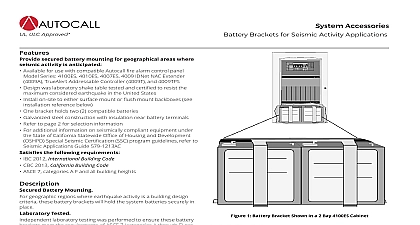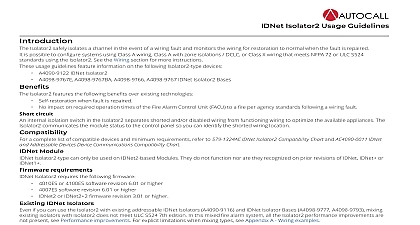Autocall Seismic Applications Guide

File Preview
Click below to download for free
Click below to download for free
File Data
| Name | autocall-seismic-applications-guide-8324705916.pdf |
|---|---|
| Type | |
| Size | 620.42 KB |
| Downloads |
Text Preview
Seismic Applications Guide Warnings and Regulatory Information AND SAVE THESE INSTRUCTIONS Follow the instructions in this installation manual These instructions must be followed to avoid damage to product and associated equipment Product operation and reliability depend upon proper installation NOT INSTALL ANY AUTOCALL PRODUCT THAT APPEARS DAMAGED Upon unpacking your Autocall product inspect the of the carton for shipping damage If damage is apparent immediately file a claim with the carrier and notify an authorized product supplier HAZARD Disconnect electrical field power when making any internal adjustments or repairs All repairs should be by a representative or an authorized agent of your local Autocall product supplier HAZARD Static electricity can damage components Handle as follows Ground yourself before opening or installing components Prior to installation keep components wrapped in anti static material at all times RULES AND REGULATIONS PART 15 This equipment has been tested and found to comply with the limits for a Class A digital device to Part 15 of the FCC Rules These limits are designed to provide reasonable protection against harmful interference when the equipment operated in a commercial environment This equipment generates uses and can radiate radio frequency energy and if not installed and used in with the instruction manual may cause harmful interference to radio communications Operation of this equipment in a residential area likely to cause harmful interference in which case the user will be required to correct the interference at his own expense REACCEPTANCE TEST AFTER SOFTWARE CHANGES To ensure proper system operation this product must be tested in accordance NFPA72 after any programming operation or change in site specific software Reacceptance testing is required after any change addition or of system components or after any modification repair or adjustment to system hardware or wiring components circuits system operations or software functions known to be affected by a change must be 100 tested In addition to ensure that operations are not inadvertently affected at least 10 of initiating devices that are not directly affected by the change up to a maximum of 50 must also be tested and proper system operation verified 72 is a registered trademark of the National Fire Protection Association Applications Guide Seismic Applications Guide SAG document is meant to provide the reader with basic information pertaining to control panels and sub that have been tested for seismic compliance under the State of California Office of Statewide Health and Development OSHPD Special Certification SSC program guidelines This document designates how to determine whether specific equipment has been certified as being compliant and elaborates on the aspects of control panel mounting and labeling and highlights specific special considerations Special Seismic Certification the years the State of California has become more and more concerned about seismic activity California considers it essential that hospital as well the hospital equipment infrastructure retain structural and functional integrity following seismic events Hospitals need to be capable treating personal injuries resulting from seismic events and continue to care for patients on hand prior to these events Several Tyco products have seismically tested and certified under the State of California Office of Statewide Health and Development OSHPD Special Seismic Certification program guidelines order to qualify for certification many of our control panels and sub assemblies have been subjected to testing under the conditions specified by ICC ES AC 156 Acceptable Criteria For Seismic Certification By Shake Table Testing of Nonstructural Components Seismic testing involves setting fully populated control panels on a shake table and demonstrating pre test functionality The equipment is then subjected to three axis shaking prescribed forces and frequencies for a designated duration The test is concluded by demonstrating post test functionality It is permissible to the equipment after the shaking panels and peripheral equipment weighing more than twenty pounds must be seismically tested by an ISO 17025 certified test laboratory must be conducted under the supervision of a State of California licensed structural engineer In addition test reports must be reviewed and by an independent State of California licensed structural engineer unless they were prepared by one Certified Equipment Fire Alarm control panels and numerous sub components have been seismically tested and qualified for certification under the control panel Under OSHPD regulations most equipment requires shake table testing Qualification by interpolation is only permitted for similar panels sub components that vary only by software color or branding every control panel and sub component has been tested and certified The Autocall control panels and related sub components that have been and approved are designated in a document filed under OSHPD Special Seismic Certification report number OSP 0004 10 The OSP 004 10 is partitioned by tables that list the various Fire Alarm and Nurse Call control panel products and sub components that have been tested and The report also includes Unit Under Test summaries that depict the basic panel configurations as well as seismic related test run information OSP 0004 10 Autocall control panels report can be obtained via the link below Rev B Considerations Location and Mounting from accessibility considerations each panel location must be capable of supporting the panel weight during seismic events Typically the control panel weights range from 30 to 65lbs while the larger 1 2 3 bay cabinet based products have weights ranging from 100 to 230 lbs maximum weight of the various control panels including the largest size batteries is listed in the OSHPD OSP 0004 10 report The panel location specific mounting fasteners types must be specified by a structural engineer to insure that the rigid wall and fasteners are capable of surviving anticipated seismic event for the given geographic area In some instances wall re enforcement may be required The OSHPD report and product instructions depict the mounting hardware diameter and grade used for testing The larger control panel products utilizing the 1 bay 2 bay 3 bay cabinets require 3 8 diameter grade 5 fasteners while the smaller lighter control panel cabinets utilize 1 4 diameter grade 5 fasteners again be sure to rely on the structural engineer to specify the panel location specific fastener type and grade Panel Labeling OSHPD seismically certified systems for hospital use in the State of California must exhibit a 0623 1936 seismic compliance label A generic label included in the ship group with each seismic battery bracket The label must be marked with a permanent marker to check off the specific panel The label needs to be applied at the customer site and it must be applied to the cabinet in an exterior location that would be readily to the building inspector The control panel cannot include any printed circuit board sub component or sub assembly that has not been tested listed in the report In addition no equipment can be added to the control panel in the future unless it appears in the report Weight peripheral equipment weighing 20 pounds or less such as detectors pull stations VO A V strobes and LCD Annunciators do not require OSHPD Specific weights of the populated panels tested are listed in the OSP 0004 10 report As noted previously for each new installation a engineer should define the location and mounting hardware to insure that the control panels will be secured properly Brackets seismically certified control panels require a battery bracket to prevent the battery pair from becoming dislodged and damaged during seismic Battery bracket kits are available for securing pairs of 12.7 18 25 33 50 Ah batteries The battery bracket kits are delivered separately and be installed at the customer site As indicated in the battery bracket installation instructions Battery Bracket Installation Instructions 579 944AC must be drilled in the cabinet to secure the bracket Bar with cards plugging into motherboards require a secondary upper stabilizer bar to prevent the cards from falling forward and becoming non Tie wraps are required to prevent the stabilizer bar from dropping out of place Media Cards network media cards must be secured in place For new network PCA assemblies a plastic retainer will be supplied for each media card The will be available for purchase to be added to panels that had been installed prior to the retainer having been designed 2017 Johnson Controls All rights reserved All specifications and other information shown were current as of document revision and are subject to change without notice Additional listings may be applicable contact your local Autocall su

